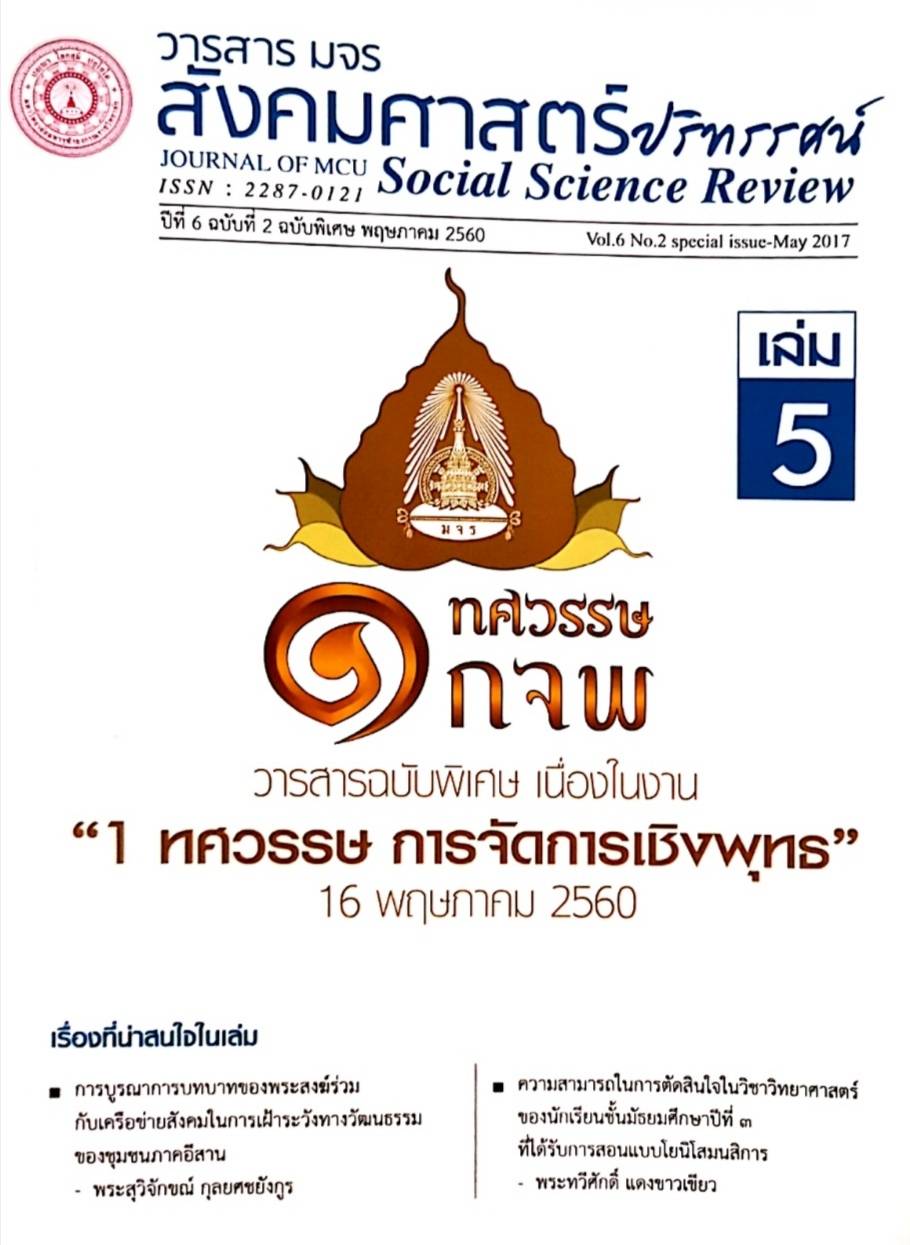ภาวะผู้นำของผู้บริหารในยุค Thailand 4.0
คำสำคัญ:
ภาวะผู้นำ, ผู้บริหาร, เศรษฐกิจยุค 4.0บทคัดย่อ
ประเทศไทยได้พัฒนาสู่ยุค Thailand 4.0 ด้วยการใช้เทคโนโลยีและความคิดที่สร้างสรรค์นวัตกรรม เพื่อเป็นฐานในการพัฒนาเศรษฐกิจ องค์การต่างๆต้องปรับตัวในกระบวนการบริหารเพื่อขับเคลื่อนองค์กรให้สอดคล้องกับทิศทางการพัฒนาหลักของประเทศ โดยอาศัยการบริหารองค์กรจากผู้บริหารที่มี “ภาวะผู้นำ”ทั้งสิ้น คุณลักษณะของผู้นำในยุค Thailand 4.0 ต้องเป็นผู้ที่มีสติปัญญาดี สามารถทำงานร่วมกับบุคคลอื่นได้ดี มีความมุ่งมั่นในการทำงาน มีคุณธรรมในตนเอง มีบุคลิกภาพดี และเป็นผู้ที่สถานะทางสังคม คุณลักษณะดังกล่าวจะสามารถบริหารงานด้วยความคิดที่สร้างสรรค์นำพาองค์กรนำไปสู่ “Value–Based Economy” ได้เป็นอย่างดี
เอกสารอ้างอิง
Bass, B. M, (1990). Bass & Stogdill’s handbook of leadership theory, research, and managerial applications. (3^rded.). New York: The Free Press.
. (1985)’ Leadership and performance beyond expectations. New York: The Free Press.
Bass, B. M., & Avolio, B. J. (1994). Improving organization effectiveness through
transformational leadership. Thousand Oaks, CA: Sage, 1994.
Bennis, W., & Nanus, B. (1985). Leaders: The strategies for taking change. New York: Harper and Row.
Bennis, W. G. (1959). Leadership theory and administrative behavior. Administrative Science Quarterly, 4.
Burns, J. M. (1978). Leadership: Theory of leadership. New York: Harper and Row, 1978.
Davis, K. (1967). Human relations at work. New York: McGraw-Hill, 1967.
Dejnozka, E. L. Education and ministration glossary. Westport, CT: Greenwood, 1983.
Department of Industrial Promotion. (2000). Study Report of small size Industrial in Thailand. Bangkok: Advanced Research Group.
Fiedler, F. E. (1967). A theory of leadership effectiveness. New York: McGraw-Hill.
Halpin, A. W. (1996). Theory and research in administration. New York: Macmillan.
Hornby, A. S., Cowle, A. P., & Lewis, J. W. (1993). Oxford advanced learner’s dictionary (4th ed.). Oxford: Oxford University Press.
Jacobs, T. O. (1970). Leadership and exchange in formal organizations. Washington, DC: Human Resources Research Organization.
Katz, D., & Kahn, R. L. (1978). The social psychology of organizations (2nd Ed.). New York: John Wiley and Sons.
Likert, R. (1967). The human organization: Its management and value. New York: McGraw-Hill.
Lunenburg, F. C., & Ornstein, A. C.(1996). Educational administration. (2nd ed.). Belmont, CA: Wadsworth.
Mosley, D. C.. (1996). Management concept and practices. New York: Harper-Collins.
Pichai Rattanadilok Na Bhuket.(2009). Organization and management .Nonthaburi:Think Beyond Book Ltd. ,
R. M. Stogdill and A. E. Coons (Eds.), Leader behavior: Its description and measurement. Bureau of Business Research. . Columbus, OH: Ohio Stage University.
Sermsak Wisalaporn. (1993). Leadership and Conflict. Bangkok: Srinakarin Thara Viroj Press.
Stogdill, R. M. Handbook of leadership. New York: The Free Press. 1974.
Trewatha, R. L., & Newport, G. M. Management (3rd ed.). Plano, TX: Business, 1982.
Phrakhrubaidikaaphichat Dhammasudho (Pornsuttichaipong), Innovation Leadership Roles for The Sangha. Administration Ministry in the next decade. Jour of MCU Peace Studies. Vol 4 No 2
(2016): 323.
R. Ornanong. 2010. Model of factors influencing innovative leader. Doctor of Public Administration. National Institute of Development Administration.
ดาวน์โหลด
เผยแพร่แล้ว
รูปแบบการอ้างอิง
ฉบับ
ประเภทบทความ
สัญญาอนุญาต
ลิขสิทธิ์ (c) 2020 วารสาร มจร สังคมศาสตร์ปริทรรศน์

อนุญาตภายใต้เงื่อนไข Creative Commons Attribution-NonCommercial-NoDerivatives 4.0 International License.
เพื่อให้เป็นไปตามกฎหมายลิขสิทธิ์ ผู้นิพนธ์ทุกท่านต้องลงลายมือชื่อในแบบฟอร์มใบมอบลิขสิทธิ์บทความให้แก่วารสารฯ พร้อมกับบทความต้นฉบับที่ได้แก้ไขครั้งสุดท้าย นอกจากนี้ ผู้นิพนธ์ทุกท่านต้องยืนยันว่าบทความต้นฉบับที่ส่งมาตีพิมพ์นั้น ได้ส่งมาตีพิมพ์เฉพาะในวารสาร มจร สังคมศาสตร์ปริทรรศน์ เพียงแห่งเดียวเท่านั้น หากมีการใช้ภาพหรือตารางหรือเนื้อหาอื่นๆ ของผู้นิพนธ์อื่นที่ปรากฏในสิ่งตีพิมพ์อื่นมาแล้ว ผู้นิพนธ์ต้องขออนุญาตเจ้าของลิขสิทธิ์ก่อน พร้อมทั้งแสดงหนังสือที่ได้รับการยินยอมต่อบรรณาธิการ ก่อนที่บทความจะได้รับการตีพิมพ์ หากไม่เป็นไปตามข้อกำหนดเบื้องต้น ทางวารสารจะถอดบทความของท่านออกโดยไม่มีข้อยกเว้นใดๆ ทั้งสิ้น





